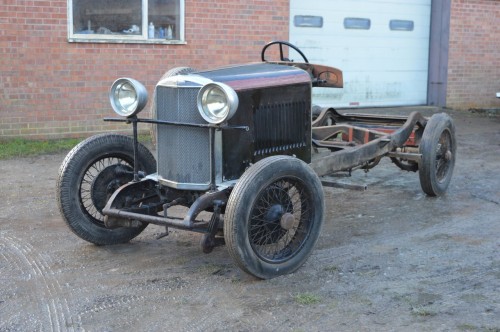
Click Here for Full Screen Image - Click Here to Download Image
 |  |  |  |  | |||||
 |  |  |  |  | |||||
 |  |  |  |  |
| Lot number | 182 |
|---|---|
| Hammer value | £10,800 |
| Description | Sunbeam 20.9 |
| Registration | LG 4416 |
| Year | 1930 |
| Colour | Blue |
| Engine size | 2,916 cc |
| Chassis No. | 2089L |
| Engine No. | 2734K |
The Sunbeam marque was a force to be reckoned with in the 1920s, manufacturing a range of superb quality cars appealing to the discerning motorist.
Clutton and Stanford wrote in their excellent book The Vintage Motor Car: 'The Sunbeams of the Vintage period and early thirties occupy a unique position. They combined smoothness with reasonably high performance and good handling. Mechanically, they showed considerable Continental influence, especially in the clean external design of the engines. In appearance they combined dignity and dash with remarkable success. To drive them is a delight, in a peculiar way, not unlike the small contemporary Rolls- Royce.'
The continental influence to which they refer came from the genius of Louis Coatalen, Sunbeam’s brilliant chief engineer. Spearheading Sunbeam’s aero engine development during WW1, Coatalen used his experience to develop Sunbeam’s racing and Land Speed Record machines in the early ‘20s. By this time the company had joined forces with Talbot and Darracq, Coatalen heavily influencing all of the offerings from the STD concern.
Perhaps his best known design was the gorgeous 3-Litre Twin Cam which showed how the company could use their enormous racing experience in a production model, however their range of 14hp, 16hp, 20hp and 25hp chassis all exhibited the same attention to detail and engineering integrity.
The 20hp was fitted with a super smooth and powerful 2,912cc six-cylinder push-rod ohv engine that had a four-bearing crankshaft and used the same bore and stroke as the Twin-Cam. Both models shared many chassis components, including the delightful and easily mastered four-speed crash gearbox. They were both initially sold with rather old fashioned cantilever rear springing, a feature which was to tarnish the sporting credentials of the Twin-Cam, but this was changed to conventional semi-elliptic springs on the 20hp from around 1930. Later 20hp models had a Dewandre brake servo and a Zenith carburettor as fitted to this rolling chassis.
According to the buff logbook, LG 4416 was sold new to Lord Dunwich of Eaton Place, London, and was fitted with a Weymann-type close coupled four-door saloon body (a photo of which is on file). The car was later sold to a Dr Vernon who lived in Ascot, before passing into the hands of the vendor’s late father via Harry Garrett’s Garage. By this time its Weymann body was well past its best and was removed, the intention being to replace it with a more sporting open alternative. Featured in Michael Ware’s column ‘Finds and Discoveries’ in Classic Cars magazine in the early 1990s, the car has remained virtually untouched since.
The engine still turns freely and even has some compression. All of the ancillaries appear to be in place, including the water-pump, dynamo, magneto and carburettor. The bulk-head was replaced and houses both horns and the autovac, while the brakes and chassis lubrication system also appear to be complete. A new dashboard was also fitted at the time of the work to the bulkhead.
Sold with a current V5 and its original handbook, the file includes some plans for its intended replacement sporting 3-seater body as fitted to a Sunbeam which was featured in the May 1926 edition of The Motor Body Builder.
This rolling chassis offers a super opportunity to build a fine sporting Sunbeam, on a basis which shares many components with the iconic Twin-Cam Super Sports. It is offered much as a rolling chassis would have left the Wolverhampton works when ordered new, is very substantially complete and in very sound condition. This straightforward re-bodying project lets the imagination run riot and has the potential to make a very fine motorcar indeed.